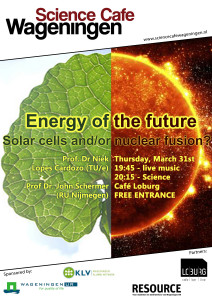 March 31st
March 31st
Summary
This night during Science Café we had a look towards the future of our energy system in the session titled “Energy of the future”. Prof. dr. Niek Lopes Cardozo (Technical University Eindhoven) and Prof. dr. John Schermer (RU Nijmegen) discussed with us on the future of nuclear fusion and solar cells.
As a starter, we could see that the Netherlands wasn’t doing all that good with regards to renewable energy. The country is still mainly dependent on fossil fuels to supply the energy required for living. And this is a problem. Prof. Lopes Cardozo showed us in clear graphs how the recent increase in world population correlates to the increase in energy use, and argued that the population can only be maintained if there is enough energy available to produce the food and materials required by these people. If available energy will follow the trend of peak-oil, the world population might do the same. An alternative energy source is thus required to maintain the growing world population.
According to prof. Cardozo, the current alternative energy sources are not substantial enough to completely fulfil our future energy requirements. A gap technology is needed that we do not have yet. One possibility is nuclear fusion, which could sustain our energy for much longer than the sun will even last. It would be clean, there is a security of supply, so what’s the drawback? It’s technically impossible: It’s hotter than the sun, we’d need something to contain and harness it that doesn’t melt. Additionally, in physics experiments we typically see lots of men staring at monitoring screens, but for a power plant we would just like to have an on/off button. In the coming 50years we therefore do not have to expect nuclear fusion to become real, but if we have to use solar and wind energy to sustain our energy need we would simply need too much space to do so.
Prof. Schermer does see a bright future for solar energy. The sun emits enough power every hour to provide the energy we are consuming in a full year (although not all of this energy reaches earth). The light energy is converted into electrical energy through photovoltaics technology, and with the current technology we would only need the area of France to cater for the global need in energy. But this is of course expensive, and the materials used are limited. In theory there are cheaper alternatives, but in practice these have lower efficiencies. New technology can go up to 40% conversion efficiency, which is better than the current 30%. This technology is already applied in space but is still quite expensive. In time we can see an increase in the efficiency of solar energy systems. The shift in records and patent holders from traditional energy companies such as BP and Shell towards modern technology companies like LG and Panasonic makes prof. Schermer optimistic. These companies are looking towards valorising the technology they own, which will definitely have an impact on the implementation of new solar energy systems into practice.
Apart from the technical side of the story, the social side also played a role in the questions from the audience. What can we say about energy security with these new systems? Who will own the energy production sites, and how will energy be distributed? Who is in power of maintaining safety? There are still many points left to discuss when we consider the future of our energy.
Gallery
Photos courtesy of Neli Prota
er zijn geen afbeeldingen gevonden
